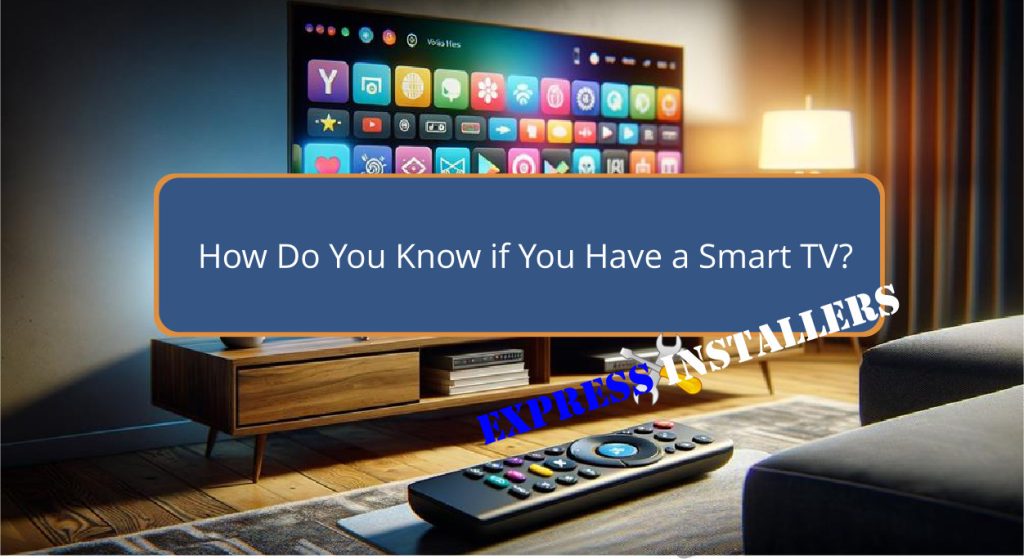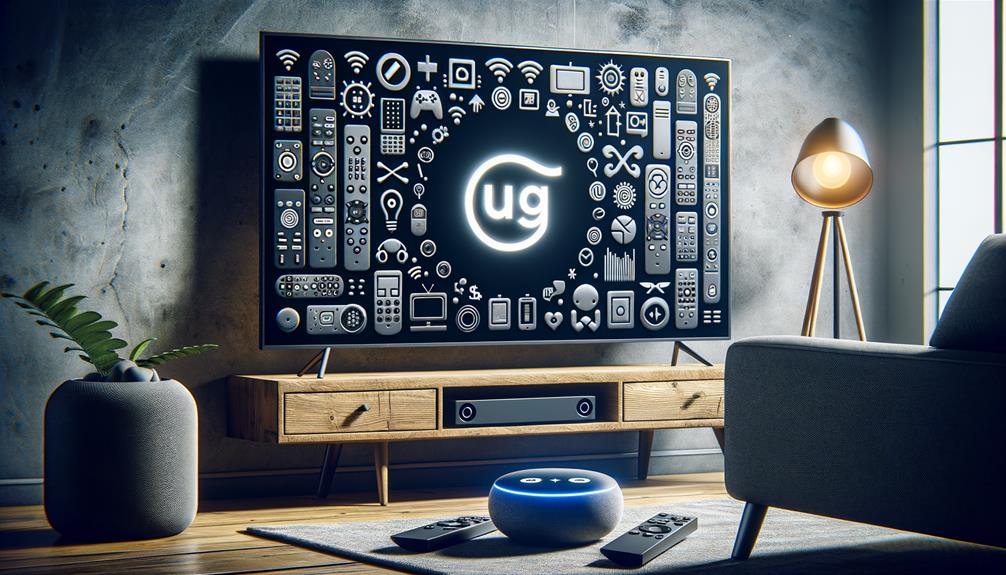
To know if your TV is a smart TV, check for built-in internet connectivity and access to an app store for streaming services.
Look at your remote for streaming service buttons and your TV’s menu for options labelled ‘Smart Hub‘ or ‘Apps’.
Inspect the back for Wi-Fi or Ethernet ports. Recognise smart TV features by brand; for instance, brands like Samsung, LG, or Sony often embed these functionalities.
If you see app icons like Netflix or YouTube on the home screen, you likely have a smart TV. If you’re curious about more detailed ways to confirm, you’re on the right track.
Quick Summary
- Look for built-in internet connectivity options like Wi-Fi or Ethernet ports.
- Check the remote for buttons dedicated to streaming services like Netflix or YouTube.
- Identify a ‘Smart’ label in the model name or on the packaging.
- Navigate the TV interface for ‘Smart Hub,’ ‘Apps,’ or similar options.
- Inspect the home screen for app icons such as Netflix, YouTube, or Amazon Prime Video.
Key Features of Smart TVs
Smart TVs come equipped with built-in internet connectivity, letting you access a wide array of streaming services and online content directly on your television.
This capability enhances your entertainment experience by providing a seamless way to watch your favourite shows and movies without needing additional devices.
One of the key Smart TV capabilities is the inclusion of app stores that often come pre-loaded with popular streaming services like Netflix and Hulu.
This allows you to quickly explore various content libraries, making it easier to find and enjoy what you love.
Another significant feature of Smart TVs is voice control integration. Many models are compatible with systems like Amazon Alexa and Google Assistant, enabling hands-free operation.
With this functionality, you can change channels, adjust volume, or search for content simply by speaking.
This integration not only adds convenience but also creates a more interactive and user-friendly experience.
To identify if your television is smart, look for indicators like the presence of ‘Smart’ or ‘Roku’ in the model name, streaming service logos on the remote, and specific smart TV settings in the menu.
These features collectively signify a robust and modern viewing experience.
Examining Connectivity Options
To determine if your TV is smart, start by checking for built-in Wi-Fi or Ethernet ports, which allow internet access.
Next, inspect the interface for streaming service apps or logos like Netflix and Hulu.
These connectivity options are strong indicators of a smart TV’s capabilities.
Wi-Fi and Ethernet Ports
When examining your TV for connectivity options, check for Wi-Fi and Ethernet ports to determine its internet capabilities. Spotting these ports is a strong indicator that your TV can connect to the internet, making it a smart TV.
Start by looking at the back of your TV for signs of built-in Wi-Fi and Ethernet ports. These features are essential for setting up connections to online content.
To help you identify whether your TV has these connectivity options, consider the following:
- Wi-Fi Indicator: Look for a Wi-Fi symbol or network settings in the TV’s menu.
- Ethernet Port: Check for a port that resembles a large phone jack, labeled ‘LAN’ or ‘Ethernet.’
- Internet Settings: Navigate to the settings menu to see if there are options for connecting to Wi-Fi or Ethernet.
- User Manual: Consult the manual for specifics on internet connectivity features.
These steps won’t only help you set up connections but also assist in troubleshooting connectivity issues.
Ensuring your TV has these ports confirms its ability to enhance your viewing experience with online content, making it a true smart TV.
Streaming Service Apps
After checking for Wi-Fi and Ethernet ports, the next step is to look for streaming service apps to further confirm your TV’s smart capabilities.
Begin by examining your remote control for logos or dedicated buttons for popular streaming services like Netflix, Hulu, or Amazon Prime Video. These buttons often indicate built-in streaming service compatibility.
Next, navigate to your TV’s main menu and explore the app store options. A smart TV typically has an app store pre-installed, offering a variety of streaming apps such as Disney+ or HBO Max.
If you can download and install these apps directly on your TV, it’s a strong indication of its smart functionality.
Additionally, verify if your TV has built-in Wi-Fi to facilitate seamless streaming. This feature is important for accessing online content without needing extra devices.
Check the TV’s settings menu to confirm it supports Wi-Fi and can connect to your home network.
Inspecting Remote and Ports

Start by checking your remote for buttons or logos from streaming services like Netflix or Amazon Prime Video, which indicate smart TV capabilities.
Next, inspect your TV for HDMI and USB ports—essential features for connecting various external devices.
These elements can quickly help you determine if your TV is indeed a smart TV.
Remote Control Features
To determine if you have a smart TV, closely examine the remote control for dedicated buttons like ‘Home,’ ‘Menu,’ or ‘Smart Hub’ that suggest smart functionality.
These buttons are key indicators that your TV can access various smart features. Additionally, look for specific buttons dedicated to popular streaming apps such as Netflix, Amazon Prime Video, or Hulu.
These buttons make it easier to launch these services directly, a hallmark of smart TVs.
Inspect the remote for a microphone button or voice control feature. Many smart TVs include voice recognition capabilities, allowing you to perform tasks hands-free.
If your remote has a built-in microphone or a dedicated button for voice commands, it’s a strong sign that your TV is smart.
Here are four key features to look for:
- Home, Menu, or Smart Hub buttons – These are common in smart TVs for accessing smart functionality.
- Streaming service buttons – Quick access to streaming apps like Netflix or Hulu.
- Microphone button – Indicates voice recognition capabilities.
- Voice control feature – Allows for hands-free operation.
HDMI and USB Ports
When determining if you have a smart TV, check for multiple HDMI and USB ports, which are essential for connecting various external devices.
Smart TVs typically feature several HDMI ports, allowing you to connect gaming consoles, streaming devices, and Blu-ray players with ease.
This port compatibility is important for a seamless entertainment experience, enabling you to switch between devices without constantly plugging and unplugging cables.
Additionally, look for USB ports on your TV. These ports are useful for connecting flash drives, external hard drives, or other USB devices, which can provide additional content or functionality.
The presence of multiple USB ports often indicates smart TV functionality, as they support a variety of external device connections.
Inspect the remote control as well. Smart TVs often come with remotes that feature dedicated buttons for streaming services, voice control, or smart home integration.
These buttons facilitate quick access to your favourite apps and enhance your overall viewing experience.
Lastly, observe if the HDMI ports are labeled for specific functions, such as ARC (Audio Return Channel) or MHL (Mobile High-Definition Link).
These specialised ports further reflect the advanced capabilities of smart TVs, ensuring excellent connectivity and performance.
Using the TV Interface
Exploring the TV interface reveals whether your television is equipped with smart features like app access and internet connectivity.
Start by browsing through the TV menu and looking for options such as ‘Smart Hub’ or ‘Apps.’ These sections typically indicate smart TV functionalities.
A user-friendly interface often includes recognisable app icons like Netflix, Hulu, or YouTube prominently displayed on the home screen.
To further confirm, delve into the settings menu. Look for options related to internet connectivity, app installation, or device pairing. If these elements are present, it’s a strong indicator that your TV is smart.
Additionally, check your remote control for a dedicated ‘Home’ or ‘Smart’ button, designed for quick access to smart functions.
Here’s a concise checklist to evoke excitement:
- Browse through the TV menu for ‘Smart Hub’ or ‘Apps’ options.
- Check for app icons like Netflix and YouTube on the home screen.
- Explore settings for internet connectivity and app options.
- Look for a ‘Home’ or ‘Smart’ button on your remote.
Consulting the user manual or visiting the manufacturer’s website can provide further details, ensuring you make the most of your smart TV functionalities.
Identifying by Brand

After examining the TV interface, another effective method to identify if you have a smart TV is by checking the brand logo on your television set.
Brand recognition plays an important role in distinguishing smart TVs from their non-smart counterparts.
Renowned brands like Samsung, LG, Sony, Panasonic, and Philips often indicate smart TV capabilities through their logos.
By performing logo identification, you can quickly ascertain your TV’s smart features.
For instance, spotting the Samsung brand logo on your TV often means it comes equipped with Smart TV features like internet connectivity and app support.
Similarly, an LG logo typically signifies access to LG’s webOS platform, which includes streaming and other smart TV capabilities.
If you see the Sony logo, it’s likely your TV has smart functionalities powered by Android TV, offering a plethora of apps and services.
Panasonic and Philips logos also suggest smart TV capabilities, with their respective platforms providing similar features like streaming services, internet browsing, and app installations.
Converting Non-Smart TVs
To convert a non-smart TV into a smart TV, you can use devices like streaming media players, smart Blu-ray players, or smart TV boxes.
These devices are budget-friendly options that connect via your TV’s HDMI port, instantly upgrading non-smart TVs with smart features.
Popular choices include Roku, Amazon Fire TV Stick, and Google Chromecast.
When you’re considering a smart TV conversion, it’s essential to compare these streaming devices. Here’s a quick breakdown:
- Roku: Offers a user-friendly interface and a vast selection of channels and apps.
- Amazon Fire TV Stick: Integrates seamlessly with Alexa for voice control and provides access to Amazon Prime Video.
- Google Chromecast: Allows you to cast content directly from your smartphone or tablet, making it great for mobile users.
- Smart Blu-ray Players: Combine traditional disc playback with smart features, perfect if you still enjoy physical media.
These devices enhance your TV’s functionality by providing access to streaming services, internet browsing, and even voice control.
By choosing the right device for your needs, you can enjoy a budget-friendly upgrade that brings your non-smart TV into the modern age.
Frequently Asked Questions
How Do I Know if My TV Is Smart?
Check your TV’s settings for internet connectivity and app access. Look for brand compatibility with streaming services and regular firmware updates. If your remote has a Smart Hub button, you likely have a smart TV.
How Can You Tell the Difference Between a Smart TV and a Regular TV?
You can tell the difference by checking for internet connectivity and streaming apps. Smart TVs have built-in Wi-Fi or Ethernet and offer access to apps like Netflix or Hulu, while regular TVs don’t.
How Do I Make My TV a Smart TV?
To make your TV a smart TV, connect streaming devices like Roku or Google Chromecast. You can also use smart adapters, gaming consoles, or media players like Apple TV to access apps and streaming services seamlessly.
Do You Need Wi-Fi With a Smart TV?
Yes, you need Wi-Fi or Ethernet for a smart TV to access streaming services and maximise its features. Internet connectivity is essential for app usage, updates, and a seamless viewing experience.
Conclusion
To determine if you have a smart TV, check for key features like Wi-Fi connectivity, app access, and an intuitive interface.
Examine your TV’s remote for dedicated app buttons and inspect the ports for HDMI and Ethernet options.
Recognise major smart TV brands or consider converting your non-smart TV with external devices like streaming sticks.
By evaluating these elements, you can confidently identify your TV’s capabilities and maximise your viewing experience.
